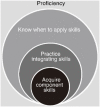Evaluation of teaching effect of first-aid comprehensive simulation-based education in clinical medical students
- PMID: 36033788
- PMCID: PMC9399416
- DOI: 10.3389/fpubh.2022.909889
Evaluation of teaching effect of first-aid comprehensive simulation-based education in clinical medical students
Abstract
Background: Although students mastered the composition skills, they lack of the ability to effectively integrate these composition skills in real clinical situations. To address the problem, we set up different levels of situational simulation training for medical students in grades 2-4, and evaluate the teaching effect of first-aid situation comprehensive simulation-based education (SBE) on clinical medical students.
Methods: The medical students in Grade 2, 3, and 4 received different situational SBE, respectively. The 2nd-year medical students received a single skill module which included cardiopulmonary resuscitation, endotracheal intubation, and electric defibrillation training. The 3rd-year medical students received a single subject module which included cardiovascular and respiratory system training. The 4th-year medical students received the integrated multidisciplinary module which combined first-aid skills, clinical thinking, and teamwork training. The primary outcome was the expert evaluation and peer evaluation. The secondary outcome was students' satisfaction questionnaire response. In our training, we arranged an adequate teaching staff for intensive training and timely feedback (the student-teacher ratio of 5:1), adequate time for repetitive practice (Each SBE was carried out within 4 h), curriculum design, and integration from real cases by clinicians, realistic computer-driven mannequins to ensure simulation fidelity, providing a different difficult level of SBE to different grades of students, and pre- and post-tests for outcome measurement.
Results: In all of the single skill module, single subject module or comprehensive disciplines module, the scores in the expert evaluation and peer assessment after the training were significantly higher than before the training, and the differences were statistically significant (p < 0.05). The integrated subject training, although having the lowest pre-and post-test marks, had the largest increase in score.
Conclusion: The first aid comprehensive simulation-based education in grade 2-4 clinical medical students, basing on timely feedback, repetitive practice, curriculum integration, simulation fidelity, and outcome measurement are effective in improving the students' proficiency in managing the real emergencies.
Keywords: clinical medical students; comprehensive; first aid; simulation-based education; teaching.
Copyright © 2022 Peng, Su, Hou, Geng, Cai, Zhong, Zhang, Zhong, Yang and Cao.
Conflict of interest statement
The authors declare that the research was conducted in the absence of any commercial or financial relationships that could be construed as a potential conflict of interest.
Figures
Similar articles
-
A Study on the Role of Intelligent Medical Simulation Systems in Teaching First Aid Competence in Anesthesiology.J Healthc Eng. 2022 Apr 21;2022:8163546. doi: 10.1155/2022/8163546. eCollection 2022. J Healthc Eng. 2022. Retraction in: J Healthc Eng. 2023 Jul 12;2023:9867315. doi: 10.1155/2023/9867315. PMID: 35494522 Free PMC article. Retracted.
-
Development and implementation of a high-fidelity simulation training course for medical and nursing collaboration based on the Fink integrated course design model.Front Med (Lausanne). 2024 Mar 5;11:1286582. doi: 10.3389/fmed.2024.1286582. eCollection 2024. Front Med (Lausanne). 2024. PMID: 38504918 Free PMC article.
-
Evaluation of medical student retention of clinical skills following simulation training.BMC Med Educ. 2019 Jul 16;19(1):263. doi: 10.1186/s12909-019-1663-2. BMC Med Educ. 2019. PMID: 31311546 Free PMC article.
-
Effectiveness of high fidelity simulation versus low fidelity simulation on practical/clinical skill development in pre-registration physiotherapy students: a systematic review.JBI Database System Rev Implement Rep. 2019 Jun;17(6):1229-1255. doi: 10.11124/JBISRIR-2017-003931. JBI Database System Rev Implement Rep. 2019. PMID: 30964770
-
Peer teacher training for health professional students: a systematic review of formal programs.BMC Med Educ. 2018 Nov 15;18(1):263. doi: 10.1186/s12909-018-1356-2. BMC Med Educ. 2018. PMID: 30442139 Free PMC article.
Cited by
-
Seizure first aid in the community: current situation, suggestions, and the role of the general practitioner in seizure management.Acta Epileptol. 2025 Mar 3;7(1):11. doi: 10.1186/s42494-025-00202-w. Acta Epileptol. 2025. PMID: 40217389 Free PMC article. Review.
-
Qualification rate and associated factors regarding COVID-19 clinical skills training based on scenario simulation teaching to medical staffs in China: a hospital-based cross-sectional study.BMC Med Educ. 2024 Jul 19;24(1):774. doi: 10.1186/s12909-024-05733-3. BMC Med Educ. 2024. PMID: 39030541 Free PMC article.
-
Barriers and Willingness to Undertake Cardiopulmonary Resuscitation Reported by Medical Students Dependent on Their Place of Residence-A Single-Center Study.Rev Cardiovasc Med. 2024 Dec 23;25(12):451. doi: 10.31083/j.rcm2512451. eCollection 2024 Dec. Rev Cardiovasc Med. 2024. PMID: 39742230 Free PMC article.
-
Enhancing Pediatric Interns' Clinical Skills Through Simulation-Based Training.Adv Med Educ Pract. 2025 Jul 10;16:1209-1216. doi: 10.2147/AMEP.S524656. eCollection 2025. Adv Med Educ Pract. 2025. PMID: 40661691 Free PMC article.
References
Publication types
MeSH terms
LinkOut - more resources
Full Text Sources



